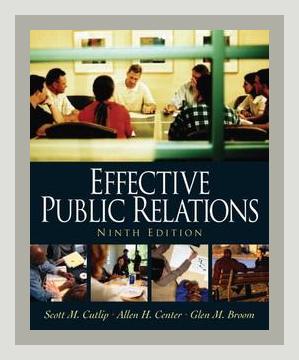Marketing and SalesPublic Relations
**
Introduction to Public Relations
“Effective Public Relations” is a seminal work in the field, first published in 1952, heralding a scientific approach to public relations (PR). It underscores the importance of PR in organizational success and delineates strategies for communication and relationship-building with various publics.
1. Defining Public Relations
Major Point: Public Relations is defined as the management function that establishes and maintains mutually beneficial relationships between an organization and the publics on whom its success or failure depends.
Actionable Advice: Develop a clear and concise definition of what public relations means within your organization to ensure all team members understand its purpose.
Example: A hospital CEO can integrate this definition into the staff orientation program to consistently align efforts towards maintaining beneficial relationships with patients, employees, and the community.
2. The Functions of Public Relations
Major Point: The primary functions of public relations include research, action, communication, and evaluation (RACE).
Actionable Advice: Implement the RACE model by scheduling regular intervals for research and evaluation to keep PR efforts data-driven and effective.
Example: A non-profit organization might conduct quarterly surveys to gather data on community needs (Research), create action plans based on findings (Action), communicate initiatives through various media (Communication), and assess the impact through feedback loops (Evaluation).
3. Research and Planning
Major Point: Effective PR starts with thorough research and meticulous planning. Research involves understanding the organization, the public, and the specific issues at hand.
Actionable Advice: Allocate a budget for regular PR research activities, such as focus groups, surveys, and media analysis.
Example: A retail company can use customer feedback surveys to understand shopping habits and preferences, then plan marketing campaigns that directly address these insights.
4. Internal Communication
Major Point: Internal communication is crucial for strengthening relationships within the organization, leading to a more unified and productive workforce.
Actionable Advice: Establish regular, open channels of communication for employees, such as town hall meetings or an internal newsletter.
Example: A tech firm can introduce a bi-weekly all-staff email update summarizing company achievements, new project announcements, and employee milestones to keep everyone informed and engaged.
5. Media Relations
Major Point: Building and maintaining a positive relationship with the media is vital for good public relations practice.
Actionable Advice: Develop a media relations strategy that includes press releases, media kits, and scheduled interactions with journalists.
Example: A restaurant chain can create press releases for new menu items, special events, or charity involvements and distribute them to local news outlets to generate positive media coverage.
6. Community Relations
Major Point: Engaging with the community and contributing to its well-being helps build goodwill and a positive organizational reputation.
Actionable Advice: Identify key community issues and contribute through sponsorships, volunteer programs, or partnerships with local organizations.
Example: A real estate company can sponsor local youth sports teams, demonstrating their commitment to the community and, in turn, fostering local trust and support.
7. Crisis Management
Major Point: Effective PR includes preparing for and managing crises to minimize damage and protect organizational reputation.
Actionable Advice: Develop a comprehensive crisis communication plan that includes clearly defined roles, communication channels, and protocols.
Example: An airline might create a crisis response team trained to handle situations like accidents or service disruptions, ensuring timely and transparent communication with the public and media.
8. Evaluation of PR Efforts
Major Point: Consistent evaluation and feedback mechanisms are essential to assess the effectiveness of PR activities and make necessary adjustments.
Actionable Advice: Implement regular evaluations using metrics like media impressions, social media engagement, and public opinion surveys.
Example: A healthcare provider might track press coverage, patient satisfaction surveys, and community outreach program results to gauge the impact of its PR strategies.
9. Public Opinion and Persuasion
Major Point: Understanding and influencing public opinion through strategic messaging and persuasive communication is a core component of PR.
Actionable Advice: Craft tailored messages that resonate with target audiences and use appropriate communication channels to disseminate them.
Example: A beverage company can create health-focused content for social media to address consumer concerns about product ingredients, thereby positively influencing public perception.
10. Ethics in Public Relations
Major Point: Adhering to ethical standards in PR to maintain credibility and trust is paramount.
Actionable Advice: Develop a code of ethics for PR professionals within the organization, ensuring all communications are transparent and truthful.
Example: A financial institution might enforce a strict policy against misleading advertising and ensure all client communications adhere to ethical guidelines.
11. Integration with Marketing
Major Point: Integrating public relations with marketing enhances overall communication strategy and achieves organizational goals more efficiently.
Actionable Advice: Collaborate closely with the marketing team to align PR and marketing objectives, ensuring consistent messaging across all platforms.
Example: An automobile manufacturer can coordinate a product launch PR campaign with its marketing department, ensuring that promotional materials and press coverage deliver a unified message.
Conclusion
“Effective Public Relations” provides a comprehensive guide for managing and improving an organization’s PR practices. By incorporating detailed research, strategic planning, maintaining media and community relations, managing crises, and conducting regular evaluations, organizations can build and sustain their public image and foster trust with their audiences. Adherence to ethical practices and integration with marketing further amplify the effectiveness of PR efforts. This book remains a foundational resource for PR professionals seeking to navigate the complex landscape of public communication and relationship management.
